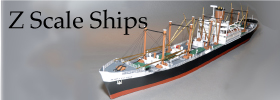Total images in all categories: 11,045
Total number of hits on all images: 21,065,996
Total number of hits on all images: 21,065,996
Another little project
Image information
Description
This is a 36-inch gauge turnout.
Date
Sunday, 14 March 2010
Hits
1956
Downloads
0
- Trust me, the builders of that turnout didn't read the NMRA recommended practices. David's turnout is pretty close, and works. Take another hard look. There is no way the guard rail will not hold the wheels on the right path. And please, don't ignore the existence of smaller wheels.<br /><br />Lajos :-)0
- The guard rail has to start before the bend on the moving rails. This makes sure that the wheels don't follow the other route. On the real picture the guard rail starts just one tie _before_ this point. On your model, the guard rail starts one tie _after_ this point. Two would be better, but one more tie is required. The most problems would be with small bogies, since one of their wheels could end up on the bad side of the frog, with the other wheels riding on the inner side of the guard rail. The rule is that the guard rails have to hold the wheels when the two moving (center) rails start to diverge and lines to check this should be drawn perpendicular to the centerlines of both routes.<br /><br />The problem rises from the fact that the gap at the tip of the frog is one tie larger on the model, so the guard rails have to be one tie longer to compensate. On the real photo the guard rails are around 4 ties long. On the model one of them is 5 ties long (that is correct) and one of them is only 3 ties long (about 2 ties too short).0
- It's actually correct. The main purpose of guard rail is to prevent the wheel flange from hitting the frog, and this shorter guard rail just do it so. There is another not well known issue. Narrow gauge railroads frequently used rolling stock, even locomotives with smaller wheels. The tire of smaller wheels tend to drop slightly into the gap between the frog and the point rail. This is very undesirable on the curved section of turnouts. Because of the centrifugal forces, the shorter guard rail let the tire of wheel move over the point rail without dropping into the gap. It works one direction only, but every little bit helps. <br /><br />Lajos :-)0
- <br />That's just the way the real one is:<br /><br />http://pinecreekrailroad.net/images/switch_1.jpgNice turnout, but one of the guard rails are a bit (two ties) short.0
- Nice turnout, but one of the guard rails are a bit (two ties) short.0
- You mean, live long enough to drive the attention of "celebritieZ" to real modeling? If so, we're on the same page.<br /><br />Lajos ;-)0
- I hope I live long enough...0
- Very neat. When your Shay will cruise through this turnout, even the "celebritieZ" must pay some attention...<br /><br />Lajos ;-)0
Filesize
49.57 KB (400 x 117 px)
Author
David K. Smith
File size of the original image
131.06 KB (1200 x 351 px)





















































































































You are not authorised to post comments.